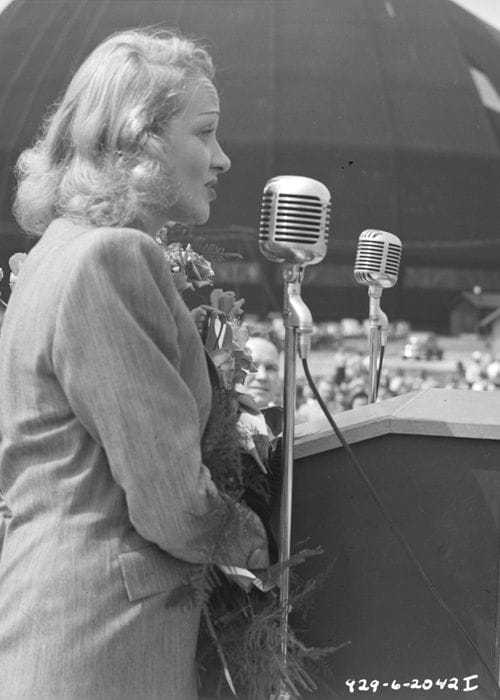Picture this:
A group of disheveled soldiers huddles around a radio with the volume turned down low. The smooth, sultry voice of Marlene Dietrich sings about a soldier leaving behind his loved one to the melody of a slow, somber march. The song is “Lili Marlene”— a very popular tune among soldiers during World War II.

Such songs could easily dampen the morale of the most steadfast soldier, which is exactly what they were meant to do.
Marlene Dietrich is best known as the first German actress to flourish in Hollywood; however, she made a significant contribution to the war effort using her talents. During World War II, Dietrich recorded a number of anti-Nazi albums in German for the Office of Strategic Services (the forerunner of today’s CIA). The albums were a part of an effort by the OSS’ Morale Operations Branch to create propaganda that would lower the morale of German soldiers.
From Chorus Girl to Movie Star
She was born Marie Magdalene Dietrich on Dec. 27, 1901 in Schöneberg, a district of Berlin, Germany. At age 11, she joined her two first names to form her new name, Marlene. She attended Auguste Victoria School for Girls and studied violin between 1906 and 1918. Her dreams of becoming a concert violinist were ruined when she injured her wrist.

In the early 1920s, Dietrich became a chorus girl and played small roles in Max Reinhardt’s theater. In 1922, she made her first film debut in So sind die M√§nner. Marlene met her husband, Rudolf Sieber, on the set of another movie that same year. The two married in May 1924.
Dietrich began to attract more and more attention as she continued to work in film and on the stage. In 1929 she landed her breakthrough role of Lola-Lola in The Blue Angel, directed by Josef von Sternberg. With encouragement from von Sternberg, Dietrich moved to the United States on contract with Paramount Pictures. Dietrich starred in six successful films between 1930 and 1935, one of which earned her an Oscar nomination.
Supporting the Effort
After moving to the United States, Dietrich claims that she was approached by Nazi Party representatives to return to Germany. She turned them down.
In 1939, Dietrich became an American citizen.
With the beginning of U.S. involvement in the war in 1941, Dietrich became one of the first celebrities to raise war bonds. She entertained the troops on the front lines by singing and playing the musical saw. In response to being asked why she chose to do this, Dietrich replied, “It was the decent thing to do.”
MUZAK Project: Music to Make Nazi Propaganda Less Effective
The OSS’ Morale Operations (MO) Branch began producing “black” radio programs in 1943 that reached listeners all over Europe and the Mediterranean. The broadcasts were meant to create friction between the Italians, Fascists, and Nazis. The stations were jammed by the Axis on several occasions.

In 1944, “black” radio in northwest Europe had soared to new heights of sophistication. The most popular station was Soldatensender (Soldiers’ Radio). In order to hold the attention of the enemy audience, the MO decided that it needed to expand to produce higher quality programming.
The MO began to recruit Hollywood writers and talent for the MUZAK project. A special MO music department was established to write “black” lyrics for German and American songs. Famous performers, such as Marlene Dietrich, Bing Crosby and Dinah Shore were asked to record these songs especially for Soldatensender. Dietrich’s “Lili Marlene” was particularly popular.
The Nazi government issued warnings not to listen to Soldatensender and banned the broadcast of “Lili Marlene.” After receiving many letters from Axis soldiers to put the song back on the air, the government reluctantly gave in. “Lili Marlene” soon became the song played at the end of every broadcast.
The MO found that the “black” radio programs were particularly effective with the enemy civilian and military populations. The United States Strategic Bombing Survey discovered that the programs were just as devastating to German morale as an air raid. The “black” programs succeeded in raising the level of skepticism so high, that many people no longer believed Nazi propaganda.

Dietrich Awarded Medal of Freedom
In 1945 the U.S. government awarded Dietrich with the Presidential Medal of Freedom, which is one of the highest civilian awards in the United States.
Dietrich said that this was the accomplishment she was most proud of in her life. She died at age 90 on May 6, 1992 in Paris.


